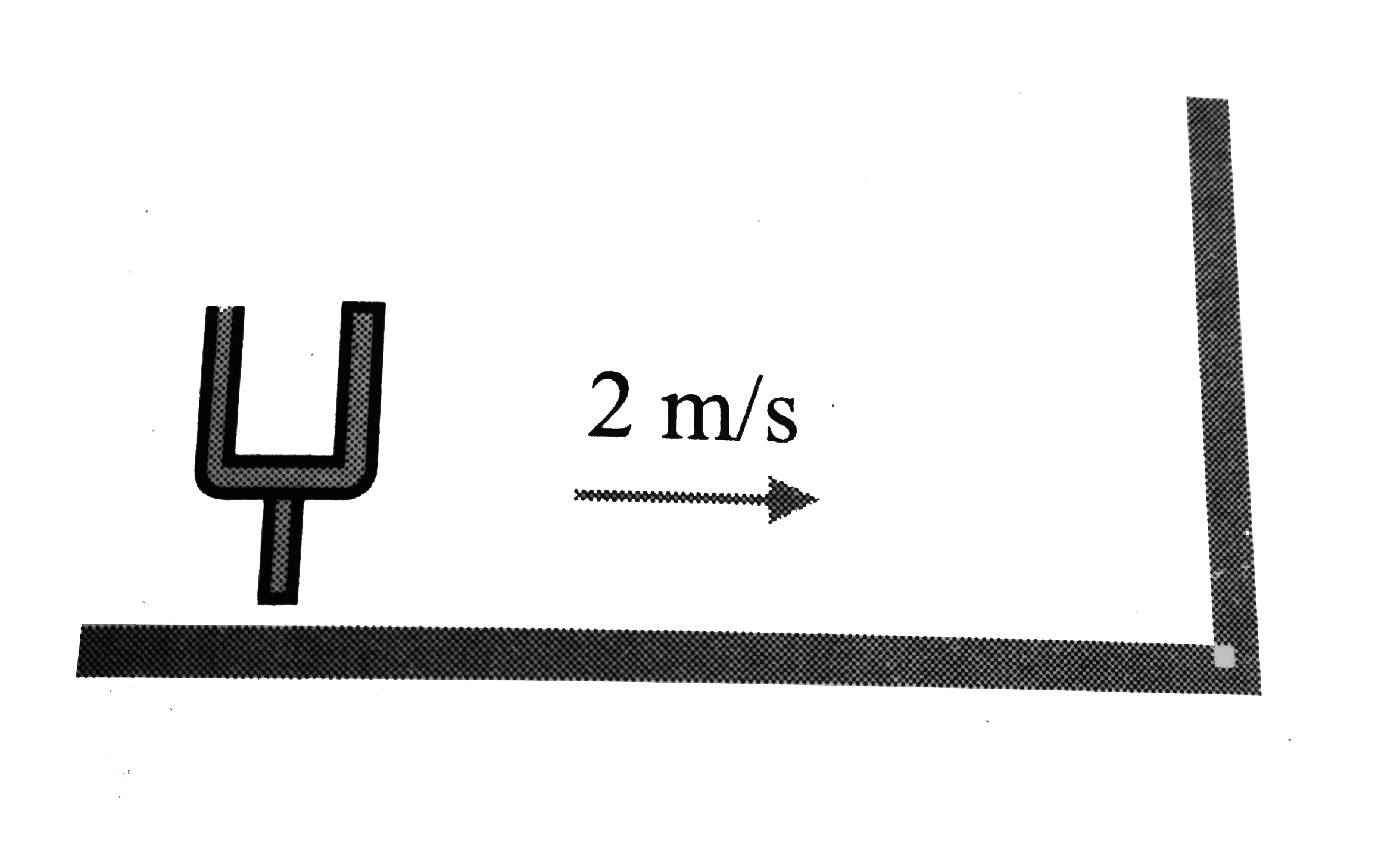A tuning fork of frequency 328 Hz is moved towards a wall at a speed of . An observer standing on the same side as the fork hears two sounds, one directly from the fork and the other reflected from the wall. How many beats per second can be heard ? (Velocity of sound in air 330 ms)
To solve the problem step by step, we will use the Doppler effect to find the apparent frequencies heard by the observer from the tuning fork and its echo.
Step 1: Calculate the apparent frequency heard directly from the tuning fork (new dash)
The formula for the apparent frequency when the source is moving towards a stationary observer is given by:
f′=fvv−vs
Where:
- f′ = apparent frequency
- f = actual frequency of the tuning fork = 328 Hz
- v = velocity of sound in air = 330 m/s
- vs = velocity of the source (tuning fork) = 2 m/s
Substituting the values:
f′=328330330−2=328330328=330 Hz
Step 2: Calculate the apparent frequency of the echo (new double dash)
When the sound reflects off the wall, it acts as a new source moving towards the observer. The formula for the apparent frequency when the source is moving towards the observer is:
f′′=fvv+vs
Here, since the echo is moving towards the observer, we use v+vs:
f′′=328330330+2=328330332
Calculating this gives:
f′′=328330332=326.5 Hz
Step 3: Calculate the number of beats per second
The number of beats per second is given by the absolute difference between the two frequencies:
n=|f′−f′′|=|330−326.5|=3.5 beats per second
Final Answer
The number of beats per second that can be heard is 3.5 beats per second.
The formula for the apparent frequency when the source is moving towards a stationary observer is given by:
- f′ = apparent frequency
- f = actual frequency of the tuning fork = 328 Hz
- v = velocity of sound in air = 330 m/s
- vs = velocity of the source (tuning fork) = 2 m/s
When the sound reflects off the wall, it acts as a new source moving towards the observer. The formula for the apparent frequency when the source is moving towards the observer is:
The number of beats per second is given by the absolute difference between the two frequencies:
The number of beats per second that can be heard is 3.5 beats per second.
Topper's Solved these Questions
- WAVE MOTION AND SOUNDBOOK - AAKASH SERIESCHAPTER - WAVE MOTION AND SOUNDEXERCISE - PROBLEMS (LEVEL - II)
97 Videos
- WAVE MOTION AND SOUNDBOOK - AAKASH SERIESCHAPTER - WAVE MOTION AND SOUNDEXERCISE - EXERCISE (VERY SHORT ANSWER QUESTIONS)
60 Videos
- WAVE MOTIONBOOK - AAKASH SERIESCHAPTER - WAVE MOTIONEXERCISE - PRACTICE SHEET ADVANCED (INTEGER TYPE QUESTIONS)
10 Videos
- WAVE OPTICSBOOK - AAKASH SERIESCHAPTER - WAVE OPTICSEXERCISE - PROBLEMS (LEVEL - II)
33 Videos
Similar Questions
A car emitting sound of frequency 500 Hz speeds towards a fixed wall at 4ms. An observer in the car hears both the source frequency as well as the frequency of sound reflected from the wall. If he hears 10 beats per second between the two sounds, the velocity of sound in air will be
View SolutionA person with vibrating tuning fork of frequency 338 Hz is moving towards a vertical wall with speed of 2ms−1 Velocity of sound in air is 340ms−1 The number of beats heard per second is
View SolutionA source of sound of frequency 256 Hz moves rapidly towards a wall with a velocity of 5ms−1. How many beats per second will be heard if sound travels at a speed of 330 m/s?
View SolutionA whistle giving 700 Hz moves away from a stationary observer towards a wall with a velocity of 2 m/s. How many beats per second are heard by the observer ? [Velocity of sound = 348m/s]
View SolutionA siren emitting a sound of frequency 2000 Hz moves away from you towards a cliff at a speed of 8 m/s.
(a) What is the frequency of the sound you hear coming directly from the siren.
(b) What is the frequency of sound you hear reflected off the cliff. Speed of sound in air is 330ms.
View Solution
A tuning fork of frequency 380 Hz is moving towards a wall with a velocity of 4ms Then the number of beats heard by a stationary listener between direct and reflected sound will be (velocity of sound in air is 340ms)
View SolutionA tunning fork of frequency 512Hz approaches a wall with a velocity of 4ms−1. How many beats are produced between the direct and the reflected sound if the velocity of sound is 332ms−1?
View Solution
As shown if Fig. a vibrating tuning fork of frequency 512 Hz is moving towards the wall with a speed 2ms. Take speed of sound as v=340ms and answer the following questions.
Q. Suppose that a listener is located at rest between the tuning fork and the wall. Number of beats heard by the listener per second will be
View Solution
As shown if Fig. a vibrating tuning fork of frequency 512 Hz is moving towards the wall with a speed 2ms. Take speed of sound as v=340ms and answer the following questions.
Q. Suppose that a listener is located at rest between the tuning fork and the wall. Number of beats heard by the listener per second will be
View SolutionA siren emitting a sound of frequency 800 Hz moves away from an observer towards a cliff at a speed of 15ms−1. Then the frequency of sound that the observer hears in the echo reflected from the cliff is (Take velocity of sound in air =330ms−1)
View Solution
